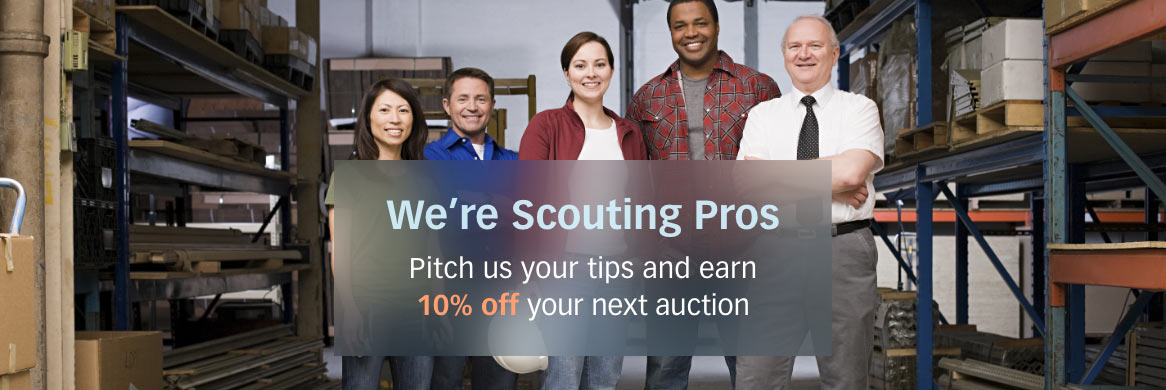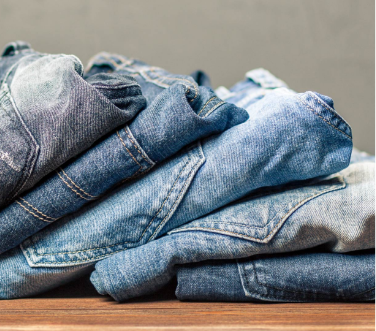Discover our Pro Tips Program.
Make a Video or Write an Article for us to Share and Earn 10% Off Your Next Auction.
The liquidation industry is more of an art than a science, and we know many Liquidation.com buyers have developed strategic approaches and crafty tactics for buying and selling overstock merchandise and even salvage items – with great knowledge and advice to offer!
If you already have a blog established, routinely post unboxing videos on Youtube or perhaps never documented your tricks of the trade, but have a fool-proof strategy you wouldn’t mind sharing with us, we’ll give you discounts on future transactions from Liquidation.com.
FOR EVERY 1 (ONE) QUALIFYING* PIECE SUBMITTED,
YOU’LL EARN 10% OFF YOUR NEXT AUCTION.
How it Works

Record a video, unboxing a Liquidation.com auction, detailing your reactions to the merchandise, your expectations for profits, where you plan to sell, etc.


Write an article detailing your tips and tricks to sourcing merchandise and/or reselling, your personal experience in this business, work-arounds that improve profits, etc.

Shelf-Pulled vs Returns Clothing Merchandise
A Buyer's Experience with Liquidation.com by Michelle Anderson
SHELF-PULLED MERCHANDISE COULD BE A HOME RUN PROVIDED IT'S BEING SOLD IN A DIFFERENT MARKET AND THE ITEM COULD BE SOLD LOCALLY.
As resellers of liquidated merchandise, we are taking advantages of weaknesses in the market. A manufacturer or store chain will often send the same amount to each store and what sells well in one market may not sell in another market, and some stores are great at distribution and logistics, while others are not.
Example: Stores all over the country sell pool chemicals, but in Minnesota, people only use their pools from May/June to August/September, but in Arizona, people use their pools almost all year-round. In September in Minnesota, pool chemicals are put on clearance and possibly liquidated, while stores in Arizona still need them.
Super basic principle, but it’s why it works to resell online as you aren’t dependent on foot traffic. Additionally, a brick and mortar store in Minnesota may not have a way to transport the chemicals to a store in Arizona, so liquidation may be more cost-effective just to liquidate.
If you’re buying from the seller “Sourced From Amazon Liquidations”, you know those items were once for sale, but didn’t for whatever reason, so you need to evaluate where you plan on selling the items to determine if they are right for your business. Other sellers on Liquidation.com may have merchandise from different stores, and you may or may not be able to determine where they came from. If you sell locally and know that everyone in your area is looking for orange shirts because it’s the color of the local high school, you might want to pick up that lot of 86 orange t-shirts, whereas other resellers might pass
TIP: Do not send “Sourced From Amazon Liquidations” merchandise back to Amazon for listing. You will be banned.
SHELF-PULLED MERCHANDISE COULD BE A HOME RUN PROVIDED YOU HAVE THE MONEY AND SPACE.
Provided the item is a commodity and simply out of season and you have the money and space to hold the inventory, you can get screaming good deals on out-of-season merchandise.
-
If I’m shopping for black ski pants, and I want brand new ones, I don’t care if they’re from this season or last as long as they have the tags. Ski pants don’t change much in overall design from season to season.
-
If I’m shopping for boxer shorts, I don’t care what the packaging looks like, but on Amazon, the item must match the listing, so if the manufacturer changes the packaging, the old merchandise must go.
-
If I see a ton of boy’s khaki pants in May when everyone else is looking for shorts and summer clothes, I’m picking those pants up because they’ll sell for back-to-school when people need school uniforms.
These kinds of things can be very profitable to get in quantity out of season; however, if neon colors were all the rage last season, but now everyone is wearing pastels, those neon colors might be a harder sell.
From the seller “Sourced From Amazon Liquidations”, I find a lot of private label items in the lots. Some are really bad and some are really good, but they might sell better locally. Private labels are all about branding, and while people are more open than they have been to non-brand items, it can be hard to be found in an online market if the buyer is searching for a brand name.
There are a lot of sellers on Amazon who are simply following gurus when they private label. Some of them still manage to do great, but in clothing, some of them struggle because the sizing is out of proportion or the item isn’t great quality, etc. So a private label item might become a shelf-pull if it didn’t sell, the seller wasn’t good at creating listings, it got too many bad reviews, or maybe the seller was from overseas and didn’t have a US address to return the items to. To me this is a big gamble.
If it’s “Sourced From Amazon Liquidations”, and was pulled because of long term storage fees assessed in February and August, you might win big if the item came from a large seller or one who is focused more on turnover. To put it another way, one who goes for the quick nickel rather than the slow dime. Again, a gamble.
There is no way to tell which third-party seller the items came from, and large volume sellers treat their inventory much differently than hobby sellers. There is also no way to tell if the items are coming from someone who knows what they are doing or someone who was blindly sending things in and has absolutely no business sense. There could be items in those lots from manufacturers in China who are sending in container loads and just plan on dumping whatever doesn’t sell. They can do this because their profits are high enough on what they do sell that even dumping hundreds of one item is nothing. They made the item, got it here for a dollar a piece and sold thousands of them for $30 a piece, so having to dump 86 of them? No biggie.
The other thing about shelf pulls in general is that you don’t always know where that shelf was located, or how long the merchandise sat before being pulled. The shelf may have been in a warehouse, and some warehouses can be dirty, dusty places; maybe the item got stepped on or run over with a fork lift or perhaps the item was on a store shelf and handled a bunch of times. I have found with Amazon, since they have increased storage fees, they tend to be cleaner than shelf pulls from other sellers, but these kinds of things do still happen, and not all Amazon sellers are diligent about pulling inventory. There are still sellers out there who let inventory sit for too long.
RETURNED MERCHANDISE AND THE EXPECTATIONS TO SET FOR YOURSELF.
First, I make a couple assumptions:
-
The highest priced item in the lot will be damaged or unsellable
-
Anything in a package will have packaging damage
If neither of those things happen, I’m pleasantly surprised, but I plan for it to happen.
Why? Because you have to think about why the item might be returned. In the case of clothing it is often because of fit, but it may be because of damage or defect, or it might have been swapped by a shady buyer. There may have been damage in the warehouse that was missed or there may have been shipping damage. The buyer may have thought the item was sage green, but it arrived and looked more like baby vomit. The buyer may have worn the item to an event and returned it to save money. Maybe the buyer pulled the tags off, or maybe they kept the tags. If the item was in a package of some kind, you can expect it to be shoved in there.
All buyers don’t try to put items back in the package neatly, but some do. If the item is no longer sealed, you must fully inspect the item to avoid reselling problems.
There will be unsellable items in clothing. In fact, I’ve had unsellable items in every lot I’ve purchased. Just plan on it.
All that being said, I like the variety of returned lots. I like that I’m not deep in one item that may or may not sell.
*A qualified piece must meet the following standards:
- A written advice piece offering tips, tricks, work-arounds, a personal experience, etc. Topics can be for both buying and/or selling. Pieces must be in written in paragraph form and may contain lists and/or bullets but must not exclusively be a list or bullets. Photos are encouraged, but not required. Each piece must contain at least 800 words.
Submitted written pieces will be reviewed by Liquidation.com where edits may be made for grammar.
- A link to a public video on Youtube or Vimeo. This can be an unboxing video, a FAQ, question/answer, merchandise walkthrough, etc. Videos cannot contain any foul language as this will disqualify from receiving a discount.
- All pieces submitted may be used for Liquidation.com marketing purposes and combined with other submitted pieces. Unless otherwise instructed in your piece submission, your first name and last name initial will be credited to your piece.
All submitted pieces will be reviewed on the first business day of every month, and discounts codes will be sent via email no later than the 15th of every month. Submissions on or after the first of every month will be reviewed the following month. The 10% discount is exclusive to the recipient of the piece and is valid for one transaction, is nontransferrable and cannot be combined with any other offer from Liquidation.com.
IMPORTANT: In order to receive your 10% promo code, you must be subscribed to our Special Alerts email campaigns. To manage your email preferences, please click here, and make sure 'Special Alerts' is checked.
Once in receipt of submitted articles or videos, Liquidation.com maintains ownership and can market material as seen fit.





